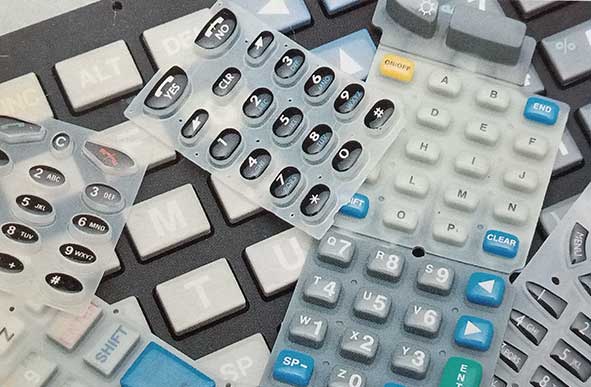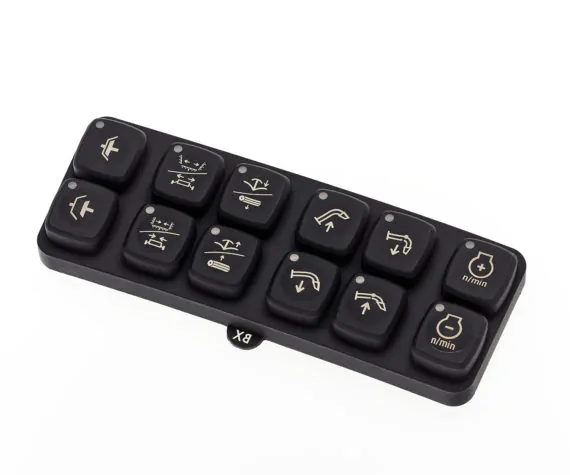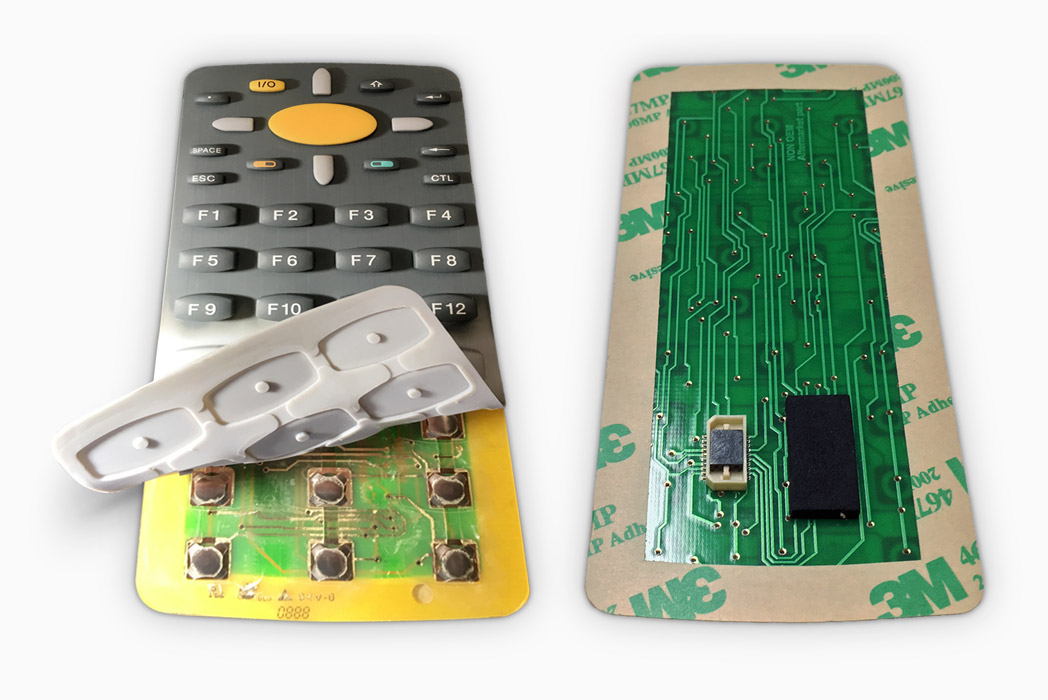The ecological footprint of producing Rubber Keypads and green solutions
Uncovering the Diverse Types and utilizes of Rubber Keypads in the Technology Landscape Today
Rubber keypads have established themselves as necessary components in various technological applications. Their adaptability makes them ideal for consumer electronic devices, commercial equipments, and clinical gadgets. As these keypads remain to develop, brand-new customization choices and layout fads emerge. This motivates a more detailed assessment of their benefits and manufacturing procedures. Recognizing these elements may reveal why rubber keypads remain a favored option in the innovation landscape. What lies ahead for this versatile component?
Overview of Rubber Keypads
Rubber keypads work as a fundamental part in numerous electronic tools, providing a tactile interface for customer communication. These keypads are generally made from silicone or rubber products, which give versatility and resilience. Their style typically integrates increased letters or icons, enhancing use by enabling customers to feel the keys - Rubber Keypads. Rubber keypads are resistant to dirt, wetness, and put on, making them appropriate for demanding environments
They can be customized relating to size, color, and form, enabling suppliers to develop distinct interfaces customized to details products. The manufacturing procedure typically entails strategies such as molding and printing, guaranteeing top quality outcome. Because of this, rubber keypads not only improve functionality however additionally add to the overall aesthetics of the gadget. With these qualities, rubber keypads continue to be a preferred choice for both producers and customers, highlighting their relevance in the technology landscape.
Common Applications in Consumer Electronic Devices
While lots of digital devices count on touchscreens for customer interaction, rubber keypads proceed to play a necessary duty in customer electronic devices. These keypads are widely used in tools such as remotes, pc gaming controllers, and family home appliances, where tactile feedback boosts customer experience. Their longevity and resistance to wear make them optimal for gadgets frequently subjected to hefty use.
Rubber keypads are additionally prominent in portable gizmos and mobile phones, where compact styles require dependable and responsive input approaches. The ability to customize the form and texture of rubber keypads permits producers to create unique designs that interest consumers. Additionally, the soft touch of rubber supplies convenience throughout extended usage, making these keypads a recommended selection for devices calling for prolonged interaction. On the whole, rubber keypads continue to be an important part in the customer electronic devices landscape, combining capability with easy to use functions.
Duty in Industrial and Medical Equipment
Rubber keypads play a vital role in both medical and commercial tools, offering longevity and reliability in demanding settings. In industrial setups, they are typically used in control panels and machinery, boosting driver interaction with complicated systems. Similarly, in the clinical field, rubber keypads help with easy to use interfaces for tools that require precision and hygiene.
Industrial Tools Applications
Keypads play a crucial function in the capability and user experience of clinical and industrial tools. In commercial setups, rubber keypads offer a robust interface for equipment and control systems, permitting operators to quickly input commands and readjust settings. Their resistance to dust, dampness, and chemicals warranties dependability under rough conditions typical of factories and manufacturing plants. Furthermore, the responsive responses offered by rubber keypads boosts customer communication, reducing the chance of input mistakes. Along with conventional equipment, these keypads are indispensable in automated robotics and systems, where precision is paramount. The convenience of rubber keypads in numerous industrial applications underscores their significance in improving functional efficiency and guaranteeing safety and security in intricate environments.
Medical Device Assimilation
As clinical gadgets progressively need easy to use interfaces, the assimilation of rubber keypads has actually become vital in making certain reliable interaction between healthcare specialists and tools. These keypads give responsive comments, assisting in intuitive operation also in high-pressure atmospheres. Their longevity and resistance to severe cleaning representatives make them excellent for clinical setups, where health and durability are vital. Furthermore, rubber keypads can be tailored to consist of different shapes, sizes, and colors, boosting aesthetic recognition and accessibility for users. This flexibility allows for the creation of specialized controls customized to specific clinical features, improving general efficiency. Consequently, the role of rubber keypads in medical device combination not only improves functionality but likewise advertises individual safety and functional integrity in healthcare settings.
Personalization Options and Style Trends

Recent design fads emphasize minimalism and comfort designs, focusing on user convenience and instinctive interaction. Customized logos and branding can be integrated into keypads, permitting firms to preserve a cohesive brand name identification throughout their products. Furthermore, developments in producing methods, such as silicone molding, have actually made it much easier to attain detailed styles and individualized layouts.
Advantages of Rubber Keypads Over Other Kinds
Rubber keypads are also recognized for their resilience and resistance to environmental variables. They can hold up against dirt, temperature level, and dampness changes, making them suitable for industrial or outside setups. Additionally, rubber keypads are frequently quieter than their plastic or metal counterparts, reducing environmental pollution in common settings.
Furthermore, the cost-effectiveness of rubber keypads makes them an appealing option for makers. Their light-weight nature adds to decrease shipping expenses, while their personalized designs cater to particular branding needs. Generally, rubber keypads represent a reputable and functional remedy in the innovation landscape.
Production Techniques for Top Quality and Resilience
In the manufacturing of rubber keypads, the choice of proper products and molding procedures plays an important function in identifying overall quality and durability. Different molding strategies, such as compression and injection molding, significantly influence the last item's performance. Comprehending these factors is vital for achieving suitable outcomes in rubber keypad production.
Molding Processes Described
A selection of molding processes play a vital role in the manufacturing of rubber keypads, making certain both high quality and sturdiness. The most usual strategies consist of compression molding, transfer molding, and shot molding. Compression molding includes putting rubber in a heated mold and mildew, where heat and pressure shape it into the wanted kind. Transfer molding permits for even more specific control over material circulation and appropriates for complex layouts (Rubber Keypads). Shot molding, recognized for its rate and performance, infuses molten rubber into a mold under high stress, generating high-volume components with constant high quality. Each method offers distinctive advantages, affecting elements such as manufacturing expense, design, and speed versatility, ultimately affecting pop over to this site the efficiency and life expectancy of rubber keypads in different applications
Material Choice Significance
Material option plays a crucial function in the production of rubber keypads, straight affecting their efficiency and sturdiness. The option of rubber compounds, such as silicone or polyurethane, impacts responsive feedback, resistance to put on, and ecological durability. Premium materials guarantee that keypads can endure substantial usage, preserving their functionality in time. Furthermore, the formula of rubber impacts its resistance to temperature changes and exposure to chemicals, which are critical for tools in various environments. Using advanced production techniques, such as compression or injection molding, further boosts the architectural integrity of keypads. Ultimately, mindful material option and production processes contribute significantly to the total quality, longevity, and individual satisfaction of rubber keypads in today's technology landscape.
Future Fads in Rubber Keypad Technology
As modern technology remains to progress, the future of rubber keypad technology shows up appealing, with advancements poised to enhance capability and individual experience. One noteworthy trend is the assimilation of touch-sensitive technology, allowing capacitive responses that imitates the feel of typical switches while offering enhanced responsiveness. In addition, the growth of antimicrobial products is most likely to acquire grip, addressing hygiene problems in public and common tools.
Furthermore, modification options are expected to broaden, allowing customers to customize crucial formats and responsive comments, thus satisfying diverse needs. The incorporation of clever innovation, such as connection features, may likewise arise, permitting rubber keypads to engage with other gadgets seamlessly. As suppliers concentrate on sustainability, environmentally friendly materials are expected to come to be extra prevalent, straightening with international ecological objectives. Generally, these patterns guarantee to reinvent rubber keypads, making them more functional, straightforward, and environmentally conscious in the modern technology landscape.
Regularly Asked Inquiries
Just How Do Rubber Keypads Compare in Price to Other Keypad Types?
Rubber keypads normally provide an economical option contrasted to various other keypad types, such as membrane layer or mechanical choices. Their reduced manufacturing expenditures and toughness make them an appealing selection for numerous applications in innovation.
What Are the Ecological Influences of Rubber Keypad Production?


The ecological effects of rubber keypad manufacturing consist of source exhaustion, power consumption, and pollution from manufacturing procedures. In addition, inappropriate disposal can result in plastic page waste, adding to environmental destruction and harming ecosystems if not handled sensibly.
Can Rubber Keypads Be Made Use Of Outdoors?
Rubber keypads can be utilized outdoors because of their sturdiness and resistance to weather components. Their long life may depend on the top quality of materials utilized and the particular environmental conditions they are revealed to.
What Maintenance Is Required for Rubber Keypads?
Rubber keypads call for routine cleansing to eliminate dirt and particles, regular inspection for damage, and protection from severe temperature levels. Guaranteeing appropriate storage space conditions can prolong their lifespan and maintain performance with time.
How Do Rubber Keypads Perform in Extreme Temperatures?
Rubber keypads typically keep capability in extreme temperature levels, exhibiting durability to both cold and heat. Prolonged exposure may trigger material destruction, influencing their tactile response and overall performance in extreme settings.
Rubber keypads offer as a fundamental component in numerous electronic gadgets, using a responsive user interface for customer interaction. While lots of digital tools depend on touchscreens for individual communication, rubber keypads continue to play an essential role in customer electronics. Additionally, the soft touch of rubber gives comfort during prolonged usage, making these keypads a favored selection for tools calling for extensive interaction. In spite of the expanding range of keypad products offered, rubber keypads offer distinctive advantages that make them a preferred selection in lots of applications. Rubber keypads typically use an affordable service compared to other keypad types, such as membrane or mechanical alternatives.